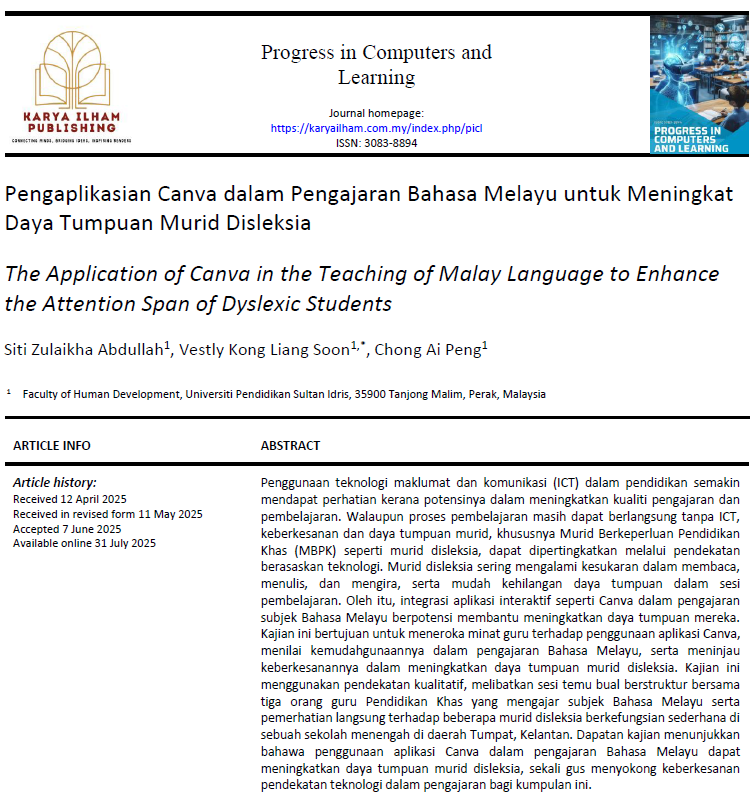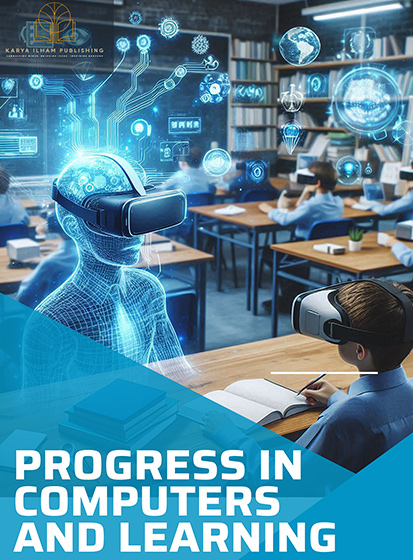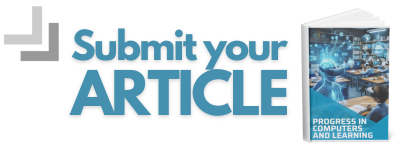Pengaplikasian Canva dalam Pengajaran Bahasa Melayu untuk Meningkat Daya Tumpuan Murid Disleksia
The Application of Canva in the Teaching of Malay Language to Enhance the Attention Span of Dyslexic Students
DOI:
https://doi.org/10.37934/picl.4.1.4048Keywords:
ICT, Canva, murid disleksia, daya tumpuan, pengajaran Bahasa Melayu, dyslexic students, attention span, Bahasa Melayu instructionAbstract
Penggunaan teknologi maklumat dan komunikasi (ICT) dalam pendidikan semakin mendapat perhatian kerana potensinya dalam meningkatkan kualiti pengajaran dan pembelajaran. Walaupun proses pembelajaran masih dapat berlangsung tanpa ICT, keberkesanan dan daya tumpuan murid, khususnya Murid Berkeperluan Pendidikan Khas (MBPK) seperti murid disleksia, dapat dipertingkatkan melalui pendekatan berasaskan teknologi. Murid disleksia sering mengalami kesukaran dalam membaca, menulis, dan mengira, serta mudah kehilangan daya tumpuan dalam sesi pembelajaran. Oleh itu, integrasi aplikasi interaktif seperti Canva dalam pengajaran subjek Bahasa Melayu berpotensi membantu meningkatkan daya tumpuan mereka. Kajian ini bertujuan untuk meneroka minat guru terhadap penggunaan aplikasi Canva, menilai kemudahgunaannya dalam pengajaran Bahasa Melayu, serta meninjau keberkesanannya dalam meningkatkan daya tumpuan murid disleksia. Kajian ini menggunakan pendekatan kualitatif, melibatkan sesi temu bual berstruktur bersama tiga orang guru Pendidikan Khas yang mengajar subjek Bahasa Melayu serta pemerhatian langsung terhadap beberapa murid disleksia berkefungsian sederhana di sebuah sekolah menengah di daerah Tumpat, Kelantan. Dapatan kajian menunjukkan bahawa penggunaan aplikasi Canva dalam pengajaran Bahasa Melayu dapat meningkatkan daya tumpuan murid disleksia, sekali gus menyokong keberkesanan pendekatan teknologi dalam pengajaran bagi kumpulan ini.
The integration of Information and Communication Technology (ICT) in education has gained significant attention due to its potential to enhance the quality of teaching and learning. Although learning can still take place without ICT, its effectiveness and students’ engagement, particularly among Special Education Needs (SEN) students such as those with dyslexia, can be significantly improved through technology-based approaches. Dyslexic students often struggle with reading, writing, and numeracy, making it difficult for them to maintain focus during lessons. Therefore, incorporating interactive applications such as Canva in Bahasa Melayu instruction has the potential to enhance their attention span. This study aims to explore teachers’ interest in using Canva, assess its usability in teaching Bahasa Melayu, and examine its effectiveness in improving the attention span of dyslexic students. A qualitative approach was employed, involving structured interviews with three Special Education teachers who teach Bahasa Melayu and direct observations of several moderate-functioning dyslexic students in a secondary school in Tumpat, Kelantan. The findings reveal that the use of Canva in Bahasa Melayu instruction can enhance the attention span of dyslexic students, thereby supporting the effectiveness of technology-based teaching approaches for this group.
Downloads
References
[1] Shaywitz, S. Overcoming Dyslexia: A New and Complete Science-Based Program for Reading Problems at Any Level, 2nd ed. Vintage, 2020.
[2] Subramaniam, V., and Kunasegran, K. "Reading Skills in Malay Language Literacy of Dyslexic Students." Jurnal Bahasa 22, no. 2 (2022): 329–346. https://doi.org/10.37052/jb22(2)no7
[3] Gathercole, S. E., and Baddeley, A. D. Working Memory and Language Processing. Psychology Press, 2014.
[4] Samsudin, S., and Alias, A. "Pengetahuan terhadap Disleksia dalam Kalangan Ibu Bapa di Sebuah Sekolah Rendah." Universiti Kebangsaan Malaysia, 2021. https://doi.org/10.33102/JQSS.VOL5NO1.116
[5] Widiastuti, D. E. "The Implementation of Canva as a Digital Learning Tool in English Learning at Vocational School." English Learning Innovation (englie) 5, no. 2 (2024): 264–276. https://doi.org/10.22219/englie.v5i2.34839
[6] Mayer, R. E. Multimedia Learning, 3rd ed. Cambridge University Press, 2021.
[7] Snowling, M. J. Dyslexia: A Cognitive-Developmental Perspective. Blackwell Publishing, 2013.
[8] Piaget, J. The Origins of Intelligence in Children. Norton, 1952.
[9] Vygotsky, L. S. Mind in Society: The Development of Higher Psychological Processes. Harvard University Press, 1978.
[10] Swanson, H. L., Harris, K. R., and Graham, S. Handbook of Learning Disabilities, 2nd ed. Guilford Publications, 2018.
[11] Bruner, J. Toward a Theory of Instruction. Harvard University Press, 1966.
[12] Shaywitz, S. E., and Shaywitz, B. A. "Dyslexia (Specific Reading Disability)." Biological Psychiatry 57, no. 11 (2005): 1301–1309. https://doi.org/10.1016/j.biopsych.2005.01.043
[13] Subramaniam, V., and Kunasegran, K. "Reading Skills in Malay Language Literacy of Dyslexic Students." Jurnal Bahasa 22, no. 2 (2022): 329–346. https://doi.org/10.37052/jb22(2)no7
[14] Skinner, B. F. Verbal Behavior. Appleton-Century-Crofts, 1957.
[15] Creswell, J. W., and Poth, C. N. Qualitative Inquiry and Research Design: Choosing Among Five Approaches, 4th ed. SAGE Publications, 2018.
[16] Merriam, S. B. Qualitative Research: A Guide to Design and Implementation, 2nd ed. Jossey-Bass, 2009.
[17] Fraenkel, J. R., and Wallen, N. E. How to Design and Evaluate Research in Education, 7th ed. McGraw-Hill, 2009.
[18] Patton, M. Q. Qualitative Research & Evaluation Methods: Integrating Theory and Practice, 4th ed. SAGE Publications, 2015.
[19] Bogdan, R., and Biklen, S. K. Qualitative Research for Education: An Introduction to Theories and Methods. Pearson, 2007.















